Difference between revisions of "Waterproofing leather"
| Line 28: | Line 28: | ||
</p> | </p> | ||
<p align=center> | <p align=center> | ||
| − | '' | + | ''A [[Finish|surface coloring]] is the best protection, but the leather does not [[Haptic evaluation of leather surfaces|feel so natural]].''<br></p> |
<p> </p> | <p> </p> | ||
| − | '''Important!''' | + | '''Important!''' A waterproofing never makes a leather as water-repellent as a [[finish|surface colouration]]. Waterproofing does not completely protect. Sensitive leather should not be exposed to bad weather despite waterproofing. |
| Line 41: | Line 41: | ||
<p> </p> | <p> </p> | ||
| − | '''Important!''' | + | '''Important!''' Sprayed waterproofing can damage the lungs. Therefore always observe the safety instructions. If sprayed outside and not positioned in the spray mist, there is no danger. The highest danger is spraying in small, enclosed rooms without ventilation. The lung does not absorb any oxygen and suffocates. Therefore, the products are marked with a strong smell to avoid inhalation. |
| − | + | The most effective are aerosol and solvent based waterproofing products. At the first treatment, waterproofing must be applied several times and must be sufficiently dried. Heat increases the waterrepellent effect. | |
| Line 54: | Line 54: | ||
<p> </p> | <p> </p> | ||
| − | + | By applying an aerosol waterrepellent, the [[Breathability of leather|breathability of the leather]] is reduced by about 5 to 10 percent. Since waterproofing is generally applied to very [[porous leather]], this reduction can be neglected. | |
| − | + | '''Important!''' Waterproofing is frequently seen as "[[leather care]]". However, waterrepellents only have the function of increasing the watertightness. A leather care is to preserve the good condition of a leather as long as possible. In addition to protecting against the penetration of moisture, leather also needs a [[Oils & fats in the leather industry|re-greasing]] depending on the type of use, so that it remains soft and / or UV filters, so that it does not [[Colour fastness - Light fastness of leather|fade]] and / or frictional wearers so that it does not wear so quickly. Therefore, an impregnation should never be considered a sufficient "leather care", but only as a moisture protection. The leather would otherwise [[Leather damages|dry out and get brittle]] over time. | |
| − | + | ||
| − | + | ||
| − | ''' | + | |
| Line 78: | Line 75: | ||
</p> | </p> | ||
<p align=center> | <p align=center> | ||
| − | '' | + | ''In case of very porous [[aniline leather]], an intensive waterproofing is not a sufficient protection. These are "nice-weather" [[Leather boots|boots]].''<br></p> |
<p> </p> | <p> </p> | ||
| − | + | ||
| + | Waterproofing doesn't makes sense on [[finish|surface-coloured]] leathers. Waterproofing does not have any care properties despite making water-repellent. It makes more sense to maintain such leather with a suitable [[leather care|care product]]. | ||
| Line 90: | Line 88: | ||
</p> | </p> | ||
<p align=center> | <p align=center> | ||
| − | '' | + | ''The first picture shows a drop of water on a [[leather colour|pigmented]] [[Cow leather|cowhide]]. The drop does not penetrate into the leather. On the other pictures the drop of water sinks into an [[aniline leather|porous aniline leather]].<br></p> |
<p> </p> | <p> </p> | ||
| Line 105: | Line 103: | ||
==Waterproof-Leder== | ==Waterproof-Leder== | ||
| − | + | Waterproof leather is a highly water-repellent leather by [[tanning leather|tanning]] and [[Oils & fats in the leather industry|re-greasing]]. Waterproof leather can contain up to 23% emulsified fats. | |
| − | + | ||
| − | + | ||
| − | + | ||
| − | + | ||
Revision as of 22:48, 5 December 2016
Contents
Waterproofing - Reproofing - Impregnation
Leather is waterproofed or hydrophobed to make it water-impermeable. The leather specialist calls it "hydrophobic leather" and the end customers calls it "waterproofed leather". Usually, shoe and clothing leather is already hydrophobed in the tannery to make it more weather-resistant.
A watterproofing treatment requires leather, which is sensitive to dampness and soiling (all porous leather like nubuck and suede and aniline leather). The waterproofing is usually applied by end consumers as an aerosol spray and renews the water repellent properties.
Advantages when moisture can not enter into porous leather:
- Breathing activity is reduced by water drawn in. A completely wet shoe or a completely wet jacket is no longer breathable.
- Feet don't get wet and also the rest of the body is protected from moisture and cold (leather pants, leather jackets, leather hats, leather gloves).
- The leather objects don't get heavy due to penetrating water.
- The stain sensitivity caused by water marks is reduced.
- Sensitive leather looks used and becomes stiffer after wetting entirely.
- Some types of soiling are reduced.
A surface coloring is the best protection, but the leather does not feel so natural.
Important! A waterproofing never makes a leather as water-repellent as a surface colouration. Waterproofing does not completely protect. Sensitive leather should not be exposed to bad weather despite waterproofing.
Suede, nubuck and aniline leather should not be exposed to excessive moisture, even with good impregnation!
Important! Sprayed waterproofing can damage the lungs. Therefore always observe the safety instructions. If sprayed outside and not positioned in the spray mist, there is no danger. The highest danger is spraying in small, enclosed rooms without ventilation. The lung does not absorb any oxygen and suffocates. Therefore, the products are marked with a strong smell to avoid inhalation.
The most effective are aerosol and solvent based waterproofing products. At the first treatment, waterproofing must be applied several times and must be sufficiently dried. Heat increases the waterrepellent effect.
By applying an aerosol waterrepellent, the breathability of the leather is reduced by about 5 to 10 percent. Since waterproofing is generally applied to very porous leather, this reduction can be neglected.
Important! Waterproofing is frequently seen as "leather care". However, waterrepellents only have the function of increasing the watertightness. A leather care is to preserve the good condition of a leather as long as possible. In addition to protecting against the penetration of moisture, leather also needs a re-greasing depending on the type of use, so that it remains soft and / or UV filters, so that it does not fade and / or frictional wearers so that it does not wear so quickly. Therefore, an impregnation should never be considered a sufficient "leather care", but only as a moisture protection. The leather would otherwise dry out and get brittle over time.
Warning sign of a leather pants made of stretch leather.
In case of very porous aniline leather, an intensive waterproofing is not a sufficient protection. These are "nice-weather" boots.
Waterproofing doesn't makes sense on surface-coloured leathers. Waterproofing does not have any care properties despite making water-repellent. It makes more sense to maintain such leather with a suitable care product.
The first picture shows a drop of water on a pigmented cowhide. The drop does not penetrate into the leather. On the other pictures the drop of water sinks into an porous aniline leather.
When water enters into porous leather, the leather fiber can swell and changes the surface and height structure. This is typical for aniline leather, which didn't get a waterproofing in the production.
The water drops have changed the surface. The edges of the water marks are swollen.
Waterproof-Leder
Waterproof leather is a highly water-repellent leather by tanning and re-greasing. Waterproof leather can contain up to 23% emulsified fats.
Video about the water sensitivity of leathers
Film about the sensitivity of smooth leather.
Additional information
![]() -> COLOURLOCK - WATERPROOF SPRAY FOR NUBUCK, SUEDE & FABRICS
-> COLOURLOCK - WATERPROOF SPRAY FOR NUBUCK, SUEDE & FABRICS
![]() -> In German: www.lederzentrum.de
-> In German: www.lederzentrum.de
![]() -> Rest of the world: partners worldwide
-> Rest of the world: partners worldwide







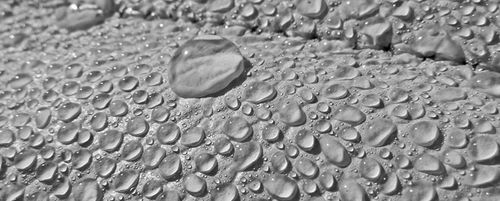

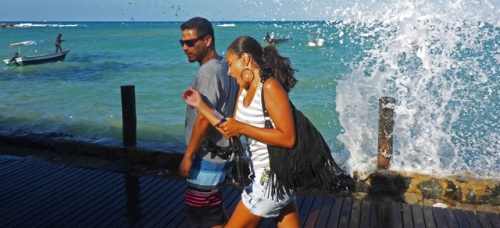

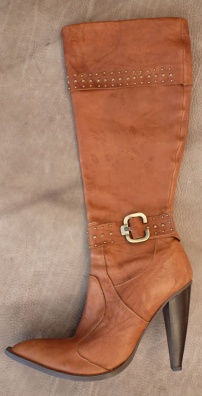
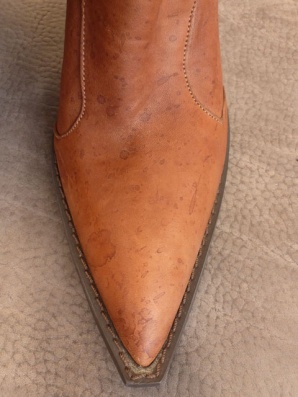
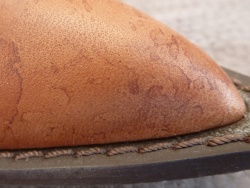
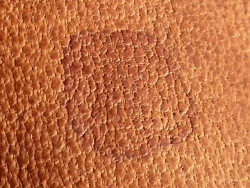




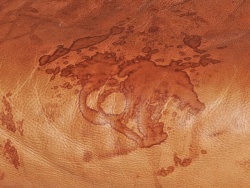
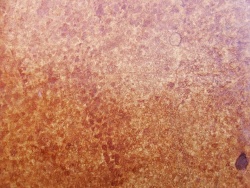

 a kotori web solution
a kotori web solution